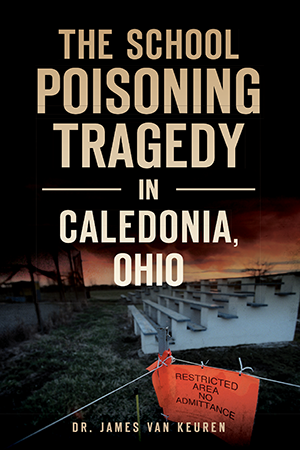
Twenty-seven thousand tons of contaminated soils. Fifty-eight thousand radioactive radium markers. A death rate from leukemia 122% higher than the rest of the state. And over fifty years of official uncertainty, misinformation, and doubt around a lethal school poisoning.
The numbers have the answer, but the question is: what the heck happened in Marion County, Ohio?
In his new book The School Poisoning Tragedy in Caledonia, Ohio, author and historian Dr. James Van Keuren tells the story of the tragic mishandling of the former Marion Engineer Depot (MED) in Caledonia, Ohio, a former World War II-era munitions handling site that left a deadly legacy for area residents. During the war years, the MED was one of the largest receiving and staging areas for weapons and materiel headed to the troops overseas. Yet the toxic chemicals used in munitions handling and storage, as well as radioactive elements found in artifacts like night-vision scopes, were improperly dumped and disposed of on-site—a fact that lay dormant for decades.

The truth would not be revealed for another thirty years, when students at River Valley High School—which had been built on the former MED site—began to show unusually high rates of cancer, particularly leukemia. Apparently building the school in the 1960s had disturbed the soil, releasing those buried contaminants, but area residents would not become aware of this fact for nearly thirty years.

As Van Keuren details, in 1997 the Ohio Department of Health began to investigate, finding area soils to contain polyaromatic hydrocarbons (a known carcinogen), arsenic, and lead, but declining to link these contaminants to the students’ illnesses. Worse still, in 1999, the US Army Corps of Engineers failed to reveal that they had found cancer-causing chemicals on the school’s athletic fields, and even when old barrels leaking hazardous waste were found near the school’s property line, government officials refused to assign responsibility—to anyone, much less to themselves.
Troublingly, as Van Keuren notes, the investigation was flawed in numerous ways. MED workers had long known of the loose handling of toxic materials and testified to the same—one former worker’s son, Ralph Hill, Jr., recalled a group of mysterious men “in what he described as moon suits coming into the family home with Geiger counters to remove furniture his father had touched, in addition to taking his father’s clothes—all without explanation.” But no accountability for the disaster was ever established, and as his book reveals, expert findings from key witnesses was either disregarded—as in the case of environmental toxicologist Dr. Bruce Molholt—or even allegedly doctored, in the case of consultant Jed Ball.

The Ohio state legislature did approve a bill to pay for the remediation of school grounds, eventually spending $35 million over a fourteen-year period (1998-2012). And in 2003, the entire school was relocated to a new site. But the damage was done. With no legal chain of accountability ever established, justice has remained elusive for the River Valley High students who fell ill—and, for those who passed away, their surviving families.

Whether the known flaws amount to a genuine cover-up may never be proved, but the evidence suggests that there is more to the story than has been revealed. It’s a sad chapter in American history, but thanks to the work of dedicated researchers like Van Keuren, at least this chapter is now, for the first time, being told.

In the early 1960s, the River Valley Local School District built its middle school, its high school and its athletic fields in the former Marion Engineer Depot. During World War II, the depot had used the land for heavy equipment rehab, military artillery practice, materials storage, burial of construction debris and burning of waste materials and fuels. In 1997, a River Valley High School nurse grew concerned about the high rate of leukemia and other cancers in graduates. Then a stunning news report announcing a 122 percent increase in death rates over thirty years in the Marion area sparked an investigation. Was the land to blame? The question of what may have been known about the contaminates on the school grounds sent shock waves through the community that still linger today.
Looking for more to read during quarantine? Check out our quaran-reads here. Finding us for the first time, and want to learn more about what we do? Visit our welcome page and sign up for the Crime Capsule email newsletter. See you behind bars!



